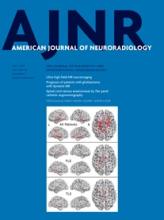Abstract
BACKGROUND AND PURPOSE: Human papillomavirus–associated oropharyngeal squamous cell carcinoma is increasing in prevalence and typically occurs in younger patients than human papillomavirus–negative squamous cell carcinoma. While imaging features of human papillomavirus–positive versus human papillomavirus–negative squamous cell carcinoma nodal metastases have been described, characteristics distinguishing human papillomavirus–positive from human papillomavirus–negative primary squamous cell carcinomas have not been well established. The purpose of this project was to evaluate the use of texture features to distinguish human papillomavirus–positive and human papillomavirus–negative primary oropharyngeal squamous cell carcinoma.
MATERIALS AND METHODS: Following institutional review board approval, 40 patients with primary oropharyngeal squamous cell carcinoma and known human papillomavirus status who underwent contrast-enhanced CT between December 2009 and October 2013 were included in this study. Segmentation of the primary lesion was manually performed with a semiautomated graphical-user interface. Following segmentation, an in-house-developed texture analysis program extracted 42 texture features from each segmented volume. A t test was used to evaluate differences in texture parameters between human papillomavirus–positive and human papillomavirus–negative squamous cell carcinomas.
RESULTS: Of the 40 included patients, 29 had human papillomavirus–positive oropharyngeal squamous cell carcinoma and 11 had human papillomavirus–negative oropharyngeal squamous cell carcinoma. Significant differences were seen in the histogram parameters median (P = .006) and entropy (P = .016) and squamous cell carcinoma entropy (P = .043).
CONCLUSIONS: There are statistically significant differences in some texture features between human papillomavirus–positive and human papillomavirus–negative oropharyngeal tumors. Texture analysis may be considered an adjunct to the evaluation of human papillomavirus status and characterization of squamous cell carcinoma.
ABBREVIATIONS:
- FDR
- false discovery rate
- GLCM
- gray-level co-occurrence matrix
- GLGM
- gray-level gradient matrix
- GLRL
- gray-level run-length
- HPV
- human papillomavirus
- SCC
- squamous cell carcinoma
- © 2015 by American Journal of Neuroradiology












